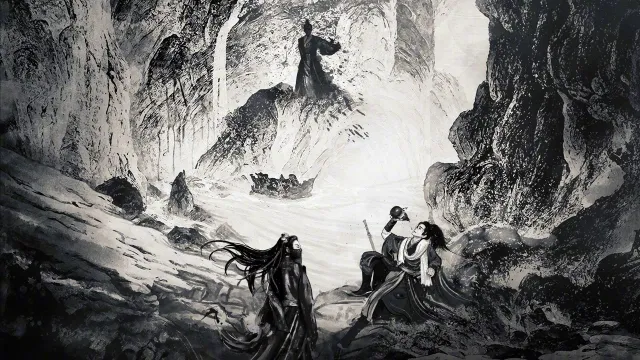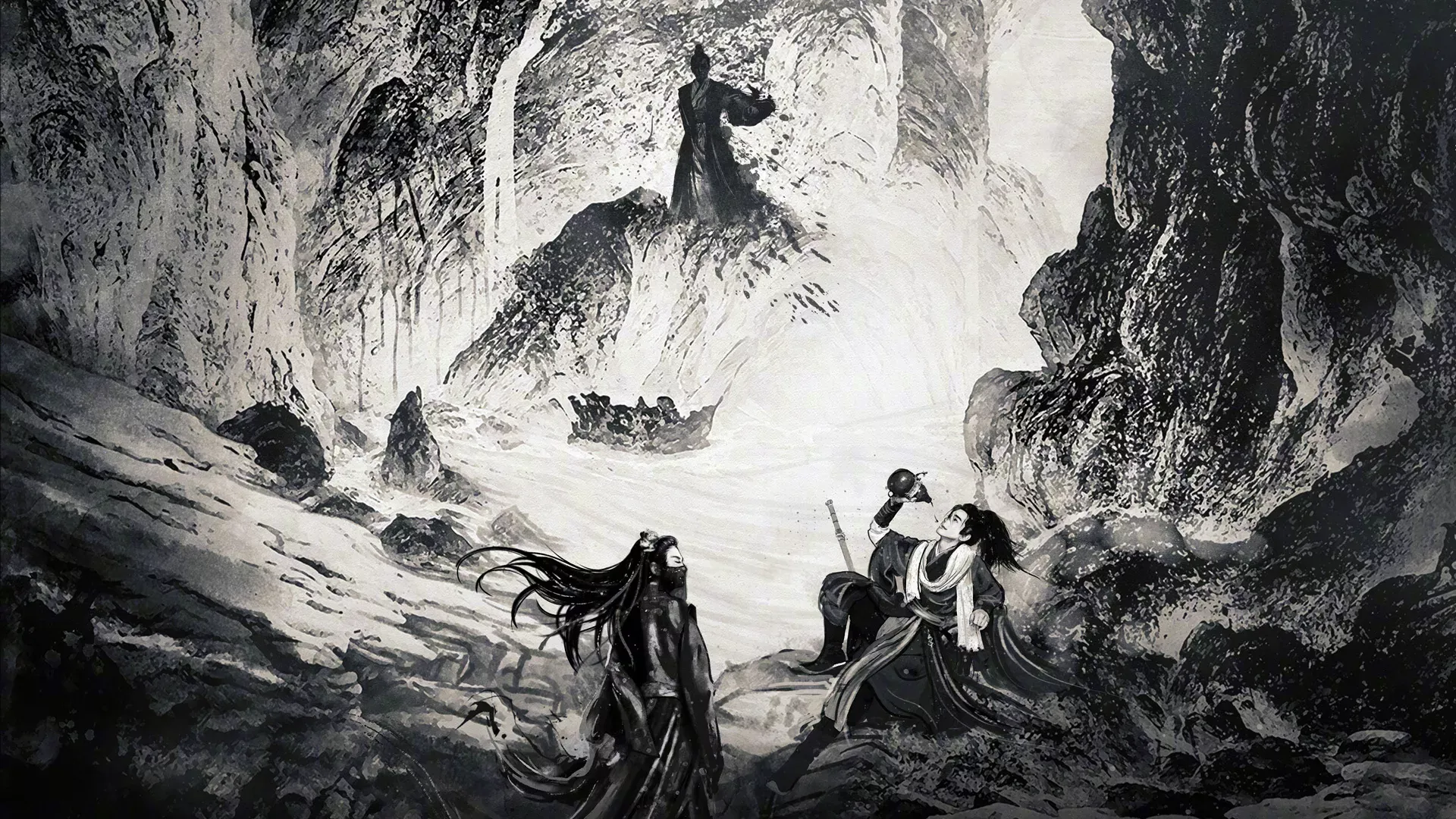The Huashan School (simplified: 华山派, traditional: 華山派, pinyin: Huáshān Pài, jyutping: waa4 saan1 paai3) was a major orthodox martial arts faction known for its elegant swordplay techniques and the internal conflicts that divided its leadership during the late Song Dynasty. The school’s reputation for producing skilled swordsmen was matched by its notoriety for the bitter rivalry between its two main factions, which ultimately led to a devastating internal conflict that weakened the entire orthodox martial arts community.
The school’s defining characteristic is its philosophical division into two major factions: the Qi Faction (气宗), which emphasizes qi cultivation, and the Sword Faction (剑宗), which prioritizes pure sword technique mastery. This fundamental disagreement about the proper path to martial excellence created decades of internal conflict that shaped the school’s history and influenced the broader martial arts world.
The Huashan School’s martial philosophy draws inspiration from Mount Hua’s defining characteristics of “uniqueness and danger” (奇险), creating fighting techniques that embody “achieving victory through unusual means and winning by taking risks” (正合奇胜,险中求胜). This approach produces practitioners who combine technical precision with tactical creativity, making them formidable opponents despite the school’s relatively small size.
The Huashan School appears across multiple time periods, from its peak influence as one of the Six Major Factions, through its golden age, to its troubled decline. Each era reveals different aspects of the school’s character while maintaining consistent themes about the relationship between individual excellence and institutional harmony.
Historical development and founding traditions
Origins and early establishment
The Huashan School traces its founding to Hao Datong, one of the Seven Zis of Quanzhen, who established the faction during the Southern Song period as an offshoot of the Quanzhen Order. This Daoist foundation provided the school with sophisticated internal cultivation methods and philosophical frameworks that distinguished it from purely martial organisations focused solely on fighting techniques.
Hao Datong’s vision emphasized the integration of Daoist spiritual practices with martial arts excellence, creating an educational system that addressed both worldly effectiveness and transcendent development. This dual focus attracted practitioners who sought more than simple combat training, drawing individuals interested in comprehensive personal cultivation that included moral development, intellectual growth, and spiritual understanding.
The choice of Mount Hua as the school’s location reflected both practical and symbolic considerations. The mountain’s dramatic terrain provided natural defensive advantages while its reputation as one of China’s Five Sacred Mountains lent spiritual authority to the institution. The challenging environment demanded physical courage and mental determination from residents, naturally selecting for individuals with the temperament necessary for advanced martial arts training.
Evolution through different dynasties
During the Yuan Dynasty period depicted in The Heavenly Sword and the Dragon Sabre, the Huashan School achieved recognition as one of the Six Major Factions, alongside Shaolin, Wudang, Emei, Kunlun, and Kongtong. Under the leadership of Xianyu Tong, known as the “Divine Calculator” (神机子), the school maintained significant influence in orthodox martial arts politics.
However, Xianyu Tong’s character flaws—described as cunning and unprincipled—began a pattern of leadership problems that would plague the school for generations. His willingness to compromise moral principles for tactical advantages created internal tensions and external reputation problems that undermined the school’s institutional health despite its continued martial excellence.
By the Ming Dynasty era of Sword Stained with Royal Blood, the school had recovered much of its prestige under Mu Renqing, the “Divine Sword Immortal Ape” (神剑仙猿). Mu Renqing’s leadership marked a golden age when the school commanded respect throughout the martial arts world and produced exceptional disciples like Yuan Chengzhi, who would become one of the era’s most influential figures.
The school’s influence during this period extended beyond martial arts into broader political affairs, with members participating in resistance movements against corrupt officials and foreign invasions. This engagement demonstrated how martial arts institutions could serve larger social purposes while maintaining their core educational and spiritual missions.
The Qi-Sword factionarian divide
The most defining event in Huashan School history was the emergence of the philosophical and practical division between the Qi Faction and Sword Faction approaches to martial arts development. This conflict reflected broader questions about the relationship between internal cultivation and external technique that affected many martial arts traditions.
The Qi Faction (气宗) advocated prioritizing internal energy development through meditation, breathing exercises, and energy circulation practices. Practitioners of this approach believed that superior internal cultivation would naturally enhance all external techniques, making specific sword training secondary to fundamental energy work. They emphasized patience, systematic development, and the integration of martial skills with spiritual growth.
The Sword Faction (剑宗) maintained that direct focus on sword technique mastery produced faster and more reliable results than indirect approaches through internal cultivation. They argued that sophisticated sword skills could overcome superior internal energy through tactical superiority, speed, and precision. This faction emphasized intensive technical training, innovative technique development, and practical combat applications.
The conflict between these approaches created irreconcilable differences about training methods, resource allocation, and the school’s fundamental mission. Neither side could convince the other of their approach’s superiority, leading to increasingly bitter disputes that eventually culminated in violent confrontation and permanent division.
Martial arts
Violet Dawn Power internal cultivation
The Violet Dawn Power (紫霞神功) is the Huashan School’s signature internal cultivation art, blending Daoist energy work with martial application. This advanced system allows practitioners to develop profound internal strength while embodying the school’s ideal of harmonizing spiritual cultivation and martial prowess.
The name refers to the purple clouds at dawn, symbolizing transformation and the emergence of power through persistent cultivation. Practitioners learn to regulate breath, circulate internal energy, and integrate mind and body, resulting in enhanced martial ability, health, and longevity.
Training Components:
- Breath regulation: Mastery of breathing and qi flow
- Meditation: Mental clarity and emotional balance
- Qi channeling: Directing internal energy for martial and health benefits
- Daoist integration: Maintaining spiritual principles in practice
Violet Dawn Power is a lifelong cultivation, growing stronger with age and discipline, and is the foundation for all advanced Huashan martial arts.
Huashan Swordplay traditions
Huashan Swordplay (华山剑法) is the school’s core sword technique system, renowned for its elegance, precision, and adaptability. The forms reflect Mount Hua’s dramatic landscape, combining graceful movement with sudden, unpredictable attacks.
The system includes numerous named techniques, each suited to different tactical situations and emphasizing both effectiveness and aesthetic beauty.
Signature Techniques:
- White Clouds Emerging from the Valley (白云出岫): Fluid movement and surprise attacks
- Phoenix Comes to Court (有凤来仪): Graceful yet powerful offensive
- Celestial Maiden Hanging Upside Down (天绅倒悬): Defensive maneuver using unorthodox angles
- Jade Maiden Threading the Needle (玉女穿针): Precision strikes to vital points
Mastery of Huashan Swordplay requires both technical skill and an understanding of underlying principles, enabling practitioners to adapt and innovate in combat.
Nine Swords of Dugu mastery
The Nine Swords of Dugu (独孤九剑) is the ultimate sword technique associated with the Huashan School, created by the legendary Dugu Qiubai and passed down by Feng Qingyang. This system emphasizes formlessness, adaptability, and the principle that “no move is the ultimate move.”
The Nine Swords are divided into categories, each designed to counter a specific type of weapon or attack, focusing on exploiting the opponent’s weaknesses rather than relying on set patterns.
Nine Sword Categories:
- General Sword Stance: Universal principles for all weapons
- Breaking Sword Stance: Countering sword users
- Breaking Saber Stance: Defeating saber techniques
- Breaking Spear Stance: Overcoming long weapons
- Breaking Whip Stance: Handling flexible weapons
- Breaking Club Stance: Countering heavy blunt weapons
- Breaking Palm Stance: Unarmed combat counters
- Breaking Projectile Stance: Defending against projectiles
- Breaking Qi Stance: Countering internal energy attacks
The Nine Swords of Dugu became Linghu Chong’s hallmark, allowing him to defeat stronger opponents through insight and technique.
Sect-specific training approaches
The division between Qi Faction and Sword Faction led to distinct training philosophies:
Qi Faction Training:
- Meditation and internal cultivation: Daily practice of Violet Dawn Power and related arts
- Gradual progression: Emphasis on patience and steady improvement
- Daoist study: Integration of philosophy and martial arts
- Health and longevity: Focus on sustainable development
Sword Faction Training:
- Intensive sword drills: Repetitive practice of forms and applications
- Combat sparring: Realistic duels and tactical training
- Innovation: Encouragement of new techniques and adaptability
- Practicality: Focus on immediate combat effectiveness
This internal diversity could have been a strength, but institutional rigidity led to destructive conflict.
Major historical periods and leadership
The Heavenly Sword and Dragon Sabre era
During the Yuan Dynasty period of The Heavenly Sword and the Dragon Sabre, the Huashan School was one of the Six Major Factions under Xianyu Tong’s leadership. However, this era marked the start of the school’s leadership decline.
Xianyu Tong, the “Divine Calculator” (神机子), was skilled and cunning but lacked moral integrity. His manipulative tactics led to internal corruption, undermining the school’s spiritual foundation.
The school’s participation in the alliance against the Ming Cult showed its influence, but Xianyu Tong’s unprincipled actions contributed to the orthodox factions’ failures.
Period Characteristics:
- Political prominence: Major role in martial arts politics
- Leadership corruption: Moral decline and internal problems
- Alliance participation: Cooperation with other orthodox factions
- Short-term tactics: Focus on immediate gain over long-term stability
Sword Stained with Royal Blood golden age
In the Ming Dynasty era of Sword Stained with Royal Blood, the school reached its peak under Mu Renqing, the “Divine Sword Immortal Ape” (神剑仙猿). Mu Renqing’s leadership combined martial excellence with moral authority.
The school was widely respected, producing outstanding disciples like Yuan Chengzhi, and played a key role in resistance against corruption and invasion.
Achievement Indicators:
- Moral leadership: Ethical guidance and martial excellence
- Exceptional disciples: Influential figures like Yuan Chengzhi
- Political engagement: Active in social justice movements
- Institutional respect: Recognized as a premier martial arts school
The Smiling Proud Wanderer decline
By The Smiling Proud Wanderer, the Huashan School had declined, despite its place in the Five Sacred Mountains Alliance. Under Yue Buqun’s leadership, the school became a symbol of hypocrisy and internal strife.
Yue Buqun, the “Gentleman Sword” (君子剑), maintained a virtuous facade while pursuing power through unscrupulous means. His actions led to internal conflict and the alienation of talented disciples like Linghu Chong.
Decline Indicators:
- Hypocritical leadership: Discrepancy between values and actions
- Internal conflict: Factional disputes and disunity
- Moral compromise: Sacrificing principles for power
- Loss of talent: Driving away exceptional individuals
Role in orthodox martial arts politics
Five Sacred Mountains Alliance membership
The Huashan School’s membership in the Five Sacred Mountains Alliance with Songshan, Taishan, Hengshan-nan, and Hengshan-bei brought both security and political pressure.
Zuo Lengchan’s attempts to unify the alliance under Songshan challenged Huashan’s independence. Yue Buqun’s response revealed both tactical skill and moral weakness.
The alliance highlighted the problems of institutional self-interest and the corruption of collective ideals.
Conflicts with unorthodox organisations
The Huashan School generally opposed unorthodox factions, seeing them as threats to order. This stance aligned it with other orthodox schools but sometimes prevented more nuanced responses.
The school’s opposition to the Sun Moon Holy Order in The Smiling Proud Wanderer reflected both real concerns and orthodox prejudice. Individual members like Linghu Chong, however, showed that personal relationships could transcend factionarian boundaries.
Government relations and political involvement
The school’s Daoist roots emphasized non-interference, but members often became involved in political resistance, especially during the Ming Dynasty. This engagement affirmed the school’s social relevance but risked compromising its spiritual mission.
Balancing independence and responsibility was a persistent challenge, reflecting broader tensions between religious ideals and worldly involvement.
Cultural and philosophical significance
Daoist foundations and adaptations
The Huashan School’s Daoist heritage shaped its martial arts and philosophy, emphasizing harmony, spontaneity, and naturalness. This produced techniques that were graceful and effective, attracting those seeking understanding as well as skill.
However, political involvement and internal conflict sometimes contradicted Daoist ideals, creating ongoing tension between philosophy and practice.
Educational philosophy and character development
Education at Huashan combined technical training with moral development, influenced by both Daoist and Confucian thought. This produced practitioners who understood the ethical responsibilities of power.
The effectiveness of this approach depended on leadership quality, as shown by the contrast between eras of principled and corrupt leadership.
Influence on martial arts development
Huashan contributed both technical innovation and philosophical debate to the martial arts world. Its emphasis on elegance and the Qi-Sword divide influenced broader discussions about training and the balance of internal and external cultivation.
Exceptional individuals like Feng Qingyang and Linghu Chong demonstrated the school’s potential for innovation and excellence.
Behind the scenes
Jin Yong uses the Huashan School to explore themes of hypocrisy, authenticity, and the effects of power. The Qi-Sword conflict represents broader questions about means and ends, and the tension between comprehensive and specialized development.
Characters like Yue Buqun and Linghu Chong illustrate different responses to institutional pressure and moral challenge.
Historical and cultural foundation
Mount Hua’s real-world association with Daoism and martial arts provides a foundation for Jin Yong’s fictional school. The integration of Daoist philosophy and martial training reflects genuine tradition, while the school’s evolution across eras shows how institutions adapt to change.
Appearances in other wuxia literature
The concept of a Mount Hua-based martial arts school appears in many wuxia works, not just Jin Yong’s, reflecting the mountain’s cultural significance. Authors like Wolong Sheng, Gu Long, and Wen Ruian have adapted the idea to their own stories.
Jin Yong’s innovations and contributions
Jin Yong’s Huashan School adds psychological and moral complexity to the wuxia tradition. His depiction of the Qi-Sword divide provides a framework for exploring different paths to personal development, and his longitudinal approach shows how institutions change over time.
Portrayals
The Huashan School has appeared in many adaptations of Jin Yong’s novels:
The Smiling Proud Wanderer
Other Adaptations
- The school appears in adaptations of The Heavenly Sword and the Dragon Sabre and Sword Stained with Royal Blood in various historical settings
- Its swordplay and Mount Hua setting are iconic in martial arts media
Most adaptations highlight the contrast between Huashan’s elegant traditions and its internal conflicts.
See also
- Unknown Novel factions
- Jin Yong factions
External links
- Huashan School (Chinese) on Baidu Baike
- Mount Hua on Wikipedia
- Sacred Mountains of China on Wikipedia


